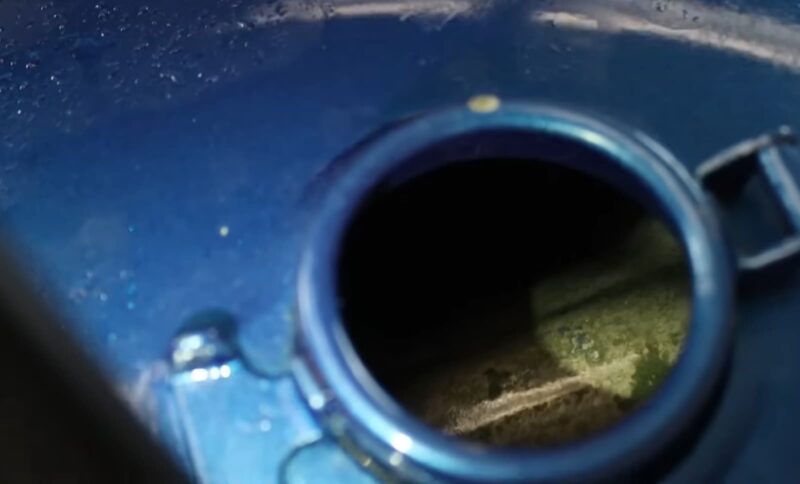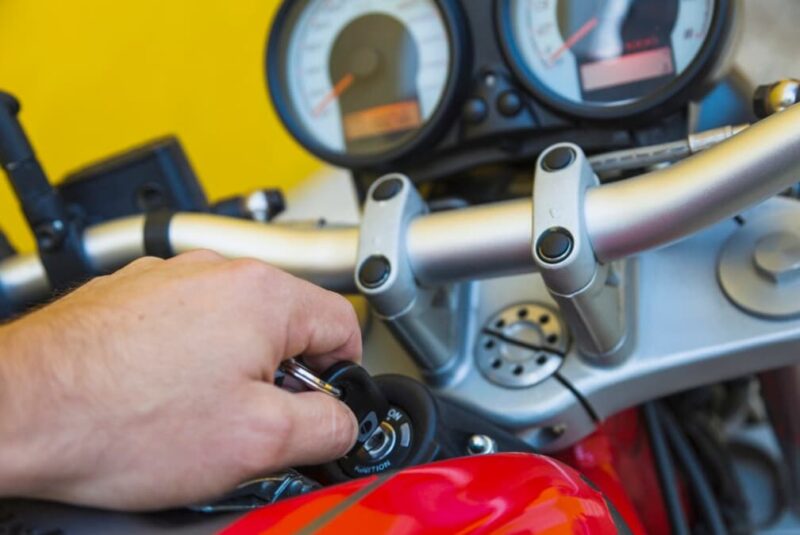
Rust can pose a significant threat, particularly when it affects your motorcycle. It does more than just lower the vehicle’s value; it can compromise both safety and functionality. When rust penetrates the gas tank, it can disperse particles that block the fuel lines, leading to reduced acceleration. Blocked filters and lines might also cause a buildup of pressure, aggravating the situation further.
Ignoring rust can result in severe damage to the engine or the corrosion of additional components of the motorcycle, possibly requiring the expensive replacement of the gas tank. Such repairs can be complex, highlighting the importance of taking steps to prevent and address rust early on.
Restoring a Rusty Fuel Tank
Keeping a fuel tank in prime condition requires proactive measures against rust. However, discovering rust on your fuel tank doesn’t have to be alarming. There are proven techniques to repair and rejuvenate a corroded fuel tank, restoring its functionality.
Methods for Removing Rust from a Motorcycle Gas Tank
Removing rust from a motorcycle gas tank can present a significant challenge, but it’s certainly achievable with the right approach. There are several methods you can employ to effectively clean rust out of a gas tank, ranging from abrasive techniques to chemical treatments and even electrolysis. Below, we’ll explore these methods in detail to help you restore your motorcycle’s gas tank to optimal condition.
Abrasive Rust Removal
Before beginning the rust removal process, ensure that your gas tank is completely emptied. Next, introduce a mixture of gravel, nuts, and bolts into the tank along with a liquid solution, such as soapy water or preferably vinegar. Seal the tank securely, ensuring all holes are closed, and vigorously shake it to ensure the abrasive materials reach every corner and effectively break down the rust buildup. Once the process is complete, drain the liquid from the tank and thoroughly rinse it with clean water, rotating it to ensure complete drainage. Finally, dry the tank thoroughly before reinstalling it onto your motorcycle.
Chemical Rust Removal
Chemical rust removal involves using potent chemicals to dissolve rust and cleanse the gas tank. One option is to utilize vinegar, similar to the abrasive rust removal method, though it may not be as robust as other chemicals available. For a safer alternative, mix vinegar with baking soda and fill the gas tank with the mixture. Allow it to sit until bubbling occurs and the color of the mixture changes due to rust dissolution. Once no further changes are observed, drain the mixture and thoroughly rinse the tank before drying.
Alternatively, diesel fuel, phosphoric acid, hydrochloric acid, acetone, or muriatic acid can be used as chemical abrasives. There are also specialized rust removal chemicals available on the market designed specifically for vehicle use. When using these chemicals, carefully follow the instructions provided on their labels to avoid mishandling and exacerbating the condition of the gas tank.
Electrolysis
Electrolysis involves the application of electricity or direct electric current through an electrolyte to induce chemical reactions that aid in breaking down rust within the gas tank. To initiate electrolysis rust removal, sodium carbonate (soda ash) is required. After introducing the solution into the gas tank, connect a battery or power source to the tank – attaching the negative terminal to the tank’s metal surface and the positive terminal to suspended iron material or an anode within the tank.
Once the power source is connected to the tank and solution, the rust will gradually disintegrate over a few hours, forming a viscous substance that can be flushed out of the tank.
Chemical Resealing Treatments
Occasionally, despite attempting various rust removal methods, stubborn rust particles may persist within the tank. To thoroughly eliminate all traces, chemical resealing treatments can be employed. This approach necessitates the use of a gas tank sealer.
Application techniques for the gas tank sealer may vary slightly depending on the brand, thus it is essential to carefully read and adhere to the instructions provided on the label.
The Cost of Rust Removal for a Motorcycle Gas Tank
Determining the cost of cleaning a rusted gas tank can vary based on the extent of treatment required. Selecting the appropriate treatment for your motorcycle’s gas tank depends on the severity of rust accumulation or your willingness to explore different options. If uncertain about which rust removal method to employ or the specific needs of your gas tank, consulting with motorcycle parts and services experts is advisable. They can provide insights into your options and assist in scheduling a rust removal service appointment tailored to your requirements.
Essential Safety Measures for Gas Tank Treatment Procedures

When utilizing various rust removal treatments for gas tanks, it’s feasible to undertake the task at home. However, it’s crucial to recognize that these potent chemicals, designed to combat stubborn rust, can pose significant hazards.
Before engaging in handling these chemicals or gas tank treatments, it’s imperative to adhere to the following safety precautions:
- Wear protective eyewear and a face mask to safeguard yourself;
- Conduct work in a well-ventilated area to mitigate exposure to concentrated fumes;
- Avoid mixing products unless specified by the manufacturer, as chemical reactions can occur;
- Ensure that heat and power sources are kept away from the work area before manipulating the gas tank or using any flammable products;
- Properly store fuel and gasoline while working on the gas tank and fuel system;
- When dealing with chemicals like acids (anything stronger than vinegar), have a hose nearby to dilute any spills promptly;
- Seal all openings in the gas tank to prevent potential leakage of hazardous chemicals.
Remember, prioritizing your health and safety is paramount. If handling potentially dangerous chemicals causes hesitation, consider seeking assistance from a rust removal expert instead.
Strategies to Prevent Rust in Your Fuel Tank
Although rust removal from a gas tank is feasible, it’s preferable to thwart rust formation altogether.
Here are effective methods to protect your gas tank from rust:
- Opt for high-octane gas and ensure regular filling. This practice minimizes the space available for condensation and water accumulation, both of which contribute to rusting;
- Initiate your engine periodically. Even if you don’t frequently ride your bike, starting it and allowing it to run for a few minutes each week prevents fuel or gas from stagnating for extended periods, which can lead to rust;
- Incorporate a fuel stabilizer. If maintaining a regular riding schedule is challenging, employing a fuel stabilizer can maintain the integrity of your gas solution and deter the formation of condensation, thereby mitigating rust development.
Maintaining and Restoring Your Vehicle’s Fuel System

Ensuring the longevity and optimal performance of our vehicles requires attention to various components, including the fuel system. Despite diligent maintenance, challenges like rust and wear can arise, affecting the condition of your fuel tank. For those looking to preserve the integrity of their fuel system or seeking solutions for a corroded fuel tank, consulting with experts is a wise approach. Professional assistance can provide the necessary interventions to keep your vehicle running smoothly and efficiently.
Conclusion
Managing rust in a motorcycle fuel tank is essential not only for preserving the value of your ride but for maintaining its safety and performance as well. Salvaging a rusty fuel tank might present a challenge, but through various methods such as abrasive removal, chemical treatments, electrolysis, and even chemical resealing, you can effectively clean and restore your gas tank. However, remember that taking preventive measures is crucial in avoiding rust formation in the first place. Also, it’s equally important to follow safety guidelines when using potentially harmful chemicals or treatments. If in doubt or if dealing with extensively rusted components, seeking professional help is always a wise choice.



